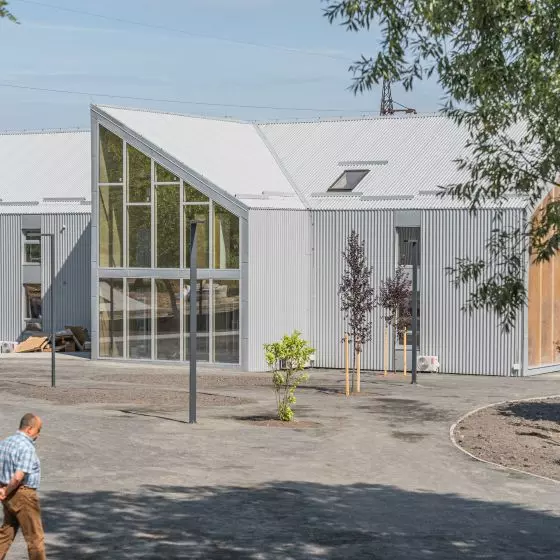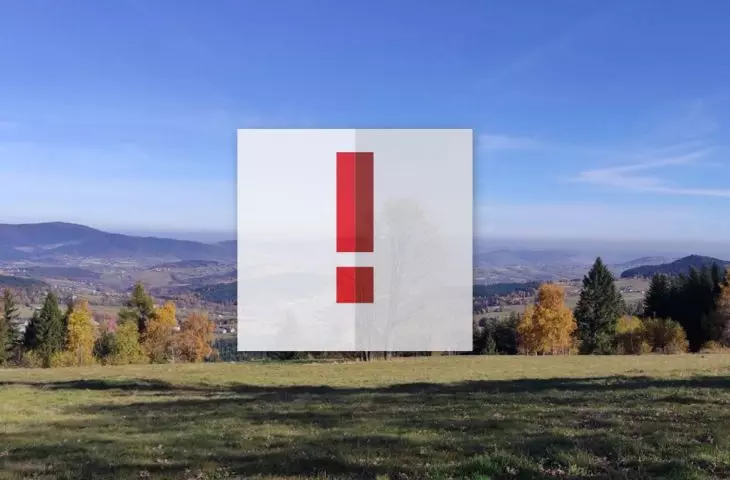The rules and regulations of the ongoing architectural competition organized by the IDEANOVA Foundation for the design of a tourist shelter with a viewing tower on the Jeżowa Woda, raise doubts in the Council of the Małopolska Regional Chamber of Architects of the Republic of Poland and the Professional Conditions Team at the Council of the Małopolska OIA of the Republic of Poland. The Council has issued a warning against participating in the competition proceedings.
The two-stage competition entitled. "Tourist hostel on the mountain Jeżowa Woda with restaurant and viewing terraces" concerns the execution of an architectural concept of a tourist hostel located in the Beskid Wyspowy, on the mountain Jeżowa Woda. As we read in the regulations—the designed object should be a place of modern character, with a form that looks into the distant future, while remaining in harmony with the surrounding nature. The highest floor should be above the treetops and be visible from all nearby peaks, yet dominate the landscape of the Beskid Wyspowy as little as possible.
However, the rules of the competition do not meet the principles recommended by the Council of the Malopolska Regional Chamber of Architects of the Republic of Poland.
content of the appeal
Below we publish the content of the warning by Olaf Jasnorzewski (Coordinator of the Professional Conditions Team at the Council of the Małopolska Regional Chamber of Architects of the Republic of Poland) and Piotr Chuchacz (Chairman of the Council of the Małopolska Regional Chamber of Architects of the Republic of Poland). The authors draw attention, to the issues that should be taken into account when deciding whether to participate in the proceedings in question. They inform that according to the document „CERTIFICATION OF COMPETITION PROCEDURES” the proceedings are eligible for the announcement of an alert.
Key issues (excerpts from the regulations have been marked * ):
Key issues:
The organizer does not indicate whether the proceedings are a public contract. The terms of the competition do not guarantee the implementation of the winning entry. Lack of a key document that is the basis for responsible preparation of the competition concept, i.e. the decision on development conditions. The functional-utility program is formulated too generally, the range of investment values is too wide, which, combined with the doubts presented below, does not guarantee objective methodical evaluation of competition concepts and valuation of future design work.
Details of the analysis:
I. COMPETITION JUDGE (based on the document Certification of Competition Proceedings).
*Ad 2. The competition jury is composed of less than 1/3 of judges (including the chairman) who are independent of the Contracting Authority and have equivalent qualifications to those required of the competition participants.
Re 2. There are eight members of the competition jury, including two architects, however, there is no information about their qualifications and professional experience. The condition of having equivalent qualifications (for at least 1/3 of the jury), to those of the contest participants is not met.
II. TRANSPARENCY OF COMPETITIONPROCEDURES (based on the document Certification of Competition Proceedings).
*5. The competition proceedings combine the stage of verification and qualification of participants with the stage of acceptance of competition works.
Re 5. The proceedings combine the stage of verification and qualification of participants with the stage of acceptance of competition works, because according to the provision of the regulations:
*2.1 In order to be admitted to the Competition, the Participants must deliver, within the time limits specified in the Regulations (Chapter I, item 7), the Competition works, drawn up in the required manner with the required attachments, with anonymity in the manner specified in these Regulations.
Re 6. The provisions of the Competition Regulations raise doubts about ensuring the anonymity of the competition works, as quoted below:
* CHAPTER IV
METHOD OF DEVELOPMENT AND SUBMISSION OF THE COMPETITION WORKS
1.1 The competition work of the first stage is to meet the following requirements—the Participant should:
1) prepare the competition work as a pdf board (graphic part in B1 format of 100x70 cm in vertical layout and description of the idea 2 pages of A4 format, maximum number of characters—5000). The board should take into account leaving a free space for the number of 5 cm x 2 cm (width x height) In the upper right corner of the board, the Organizer (Coordinator of the Contest) will label them with the assigned number, which will be sent to the Participant's email address indicated during registration.
2) Include in the name of each of the files sent electronically, in capital letters, the name and surname or name of the Participant,
3) write in the title of the e-mail with the submitted work the slogan: COMPETITION—"TOURIST SCHRONISKO",
4) send his/her Contest work to the Organizer by e-mail, in the form of PDF files attached to the e-mail (prepared in accordance with the scheme given above) or an interactive link in the body of the e-mail with the address of the server on which this work is located (files of up to 3 GB).
1.2 Until the settlement of the Competition, the identification of the Participants—authors of the competition works—by the members of the Jury, should be impossible. For this purpose, the works must be prepared in a manner that ensures their anonymity. In particular: the Contest work, along with the description, must not, bear the name, surname, pseudonym or other information that allows identifying the Participant.
Ergo the work is encrypted, but the uploaded files may contain some meta data that can be used to identify the contest participant.
III. AGREEMENT (based on the document Certification of Competition Proceedings).
14 The terms and conditions of the competition do not include a full model agreement
Re 14. in the terms and conditions of the competition No model agreement, also no IPU.
In addition, a provision obliging the author of the project to sign a separate agreement for the transfer of the property rights to his project is unacceptable, if the terms and provisions of the cited „separate agreement” are not an appendix to these Regulations.
*10.3. By submitting works to the Competition, the Participant who is the author of the winning project undertakes that, in the event of winning the Competition, he/she will conclude with the Organizer a separate agreement on the transfer of property copyright to his/her project, under pain of losing the right to thefinancial prize, including authorization to grant permission to use derivative rights to such extent as will be necessary for the preparation of the architectural design, construction of the object and realization of the purpose of the competition. The design will be used to realize only the object referred to in the Competition Regulations and will not be used to prepare other objects.
15 The fee for the design documentation (post-competition) provided for in the terms and conditions of the competition has not been calculated in accordance with the Decree of the Minister of Development and Technology of December 20, 2021 on determining the methods and bases for preparing the investor's cost estimate, calculating the planned costs of design works and the planned costs of construction works specified in the functional-utility program (Journal of Laws 2021 item 2458.).
Re 15 The fee for the design documentation was not specified in the competition terms and conditions, and the method of calculating the planned costs of the design work was not specified. In addition, the provision of the competition terms and conditions stating that the Organizer reserves the right to cancel the Competition without stating the reason is objectionable. This may, result in the indefinite use of the competition works in its possession for promotional purposes in accordance with the provision:
*10.2 By submitting a Competition work (project) to the Competition, the Participant:
(a) grants a royalty-free, indefinite, non-exclusive license for the Organizer to use his/her work, but only for the purpose of its dissemination on the Internet as well as inprinted materials, both during and after the Contest, as part of informing the public about the Contest and presenting it at any exhibitions, including those organized by them.
The Contest organizer acquires the rights to the promotional materials unlimited in time, without payment to the authors who made the promotional materials.
Comments
In addition to the above-mentioned doubts, the authors of the appeal suggest consulting the regulation of the material provisions of the contract (IPU) with the insurance company with which those wishing to participate in the competition have a liability policy. There is a high probability that the scope of the regulation goes beyond the scope of liability coverage. In such a situation, they suggest analyzing the economic and professional security for this action.
Thepurpose of the activities of the Council of the Malopolska OIA of the Republic of Poland is not to demonstrate the incompatibility of the proceedings with the public procurement law, especially since, the organizer does not inform whether the proceedings are public procurement. The Council takes action in connection with the social interest of optimizing the expenditure of public funds and in an effort to achieve the right conditions for the implementation of the tasks that have been set before the architectural profession.
Thebasis are the provisions of the Act of December 15, 2000 on professional self-governments of architects and construction engineers (Journal of Laws of 2014, item 1946, as amended).
Based on Article 8. the tasks of professional self-governments include, in particular:
1) to supervise the proper and conscientious practice of the profession by members of the chambers,
2) to represent and protect the professional interests of its members,
(...)
6) cooperating with government administration bodies and local government bodies, as well as with other professional self-governments and professional associations.
(...)
In addition, § 6 of the Statute, of the Chamber of Architects of the Republic of Poland, defines the objectives of the Chamber of Architects:
The Chamber's primary objective is to protect space and architecture as a public good. The Chamber pursues this goal by ensuring the proper performance of independent technical functions in the construction industry and by overseeing the performance of construction expertise in the field of architecture.
The analysis is based on the Certification of Competition Proceedings prepared by the Team of Conditions of Practice of the Profession at the Council of the MPOIA of the Republic of Poland (Krakow March 2017, revised November 2022).














